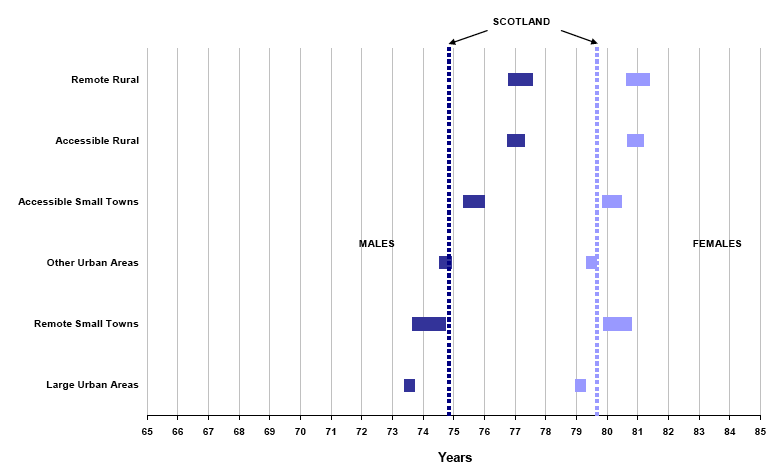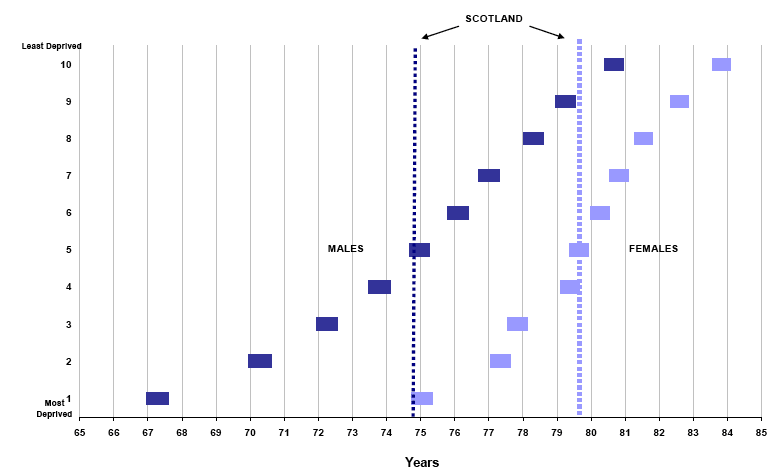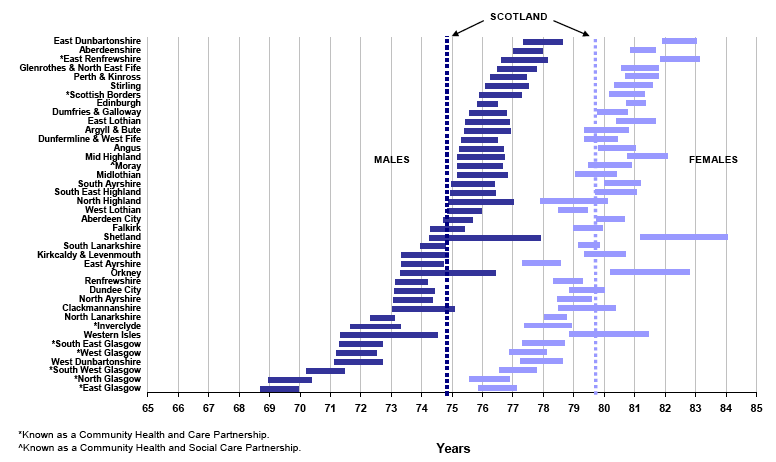
Men have a shorter life expectancy than women both in Scotland generally and within each CHP, Urban Rural and Deprivation area. There is, however, much variation from place to place.
2.1 Life Expectancy by Urban Rural Classification
In the previous report in this series of publications ( Life Expectancy in Special Areas 2004-2006) life expectancy in urban and rural areas was calculated using the Scottish Governments 2005-2006 Urban Rural Classification. This set of life expectancy figures are based on the 2007-2008 Urban Rural Classification.
Table 1, Table 6and Figure 1 show that the shortest male life expectancy at birth (73.5 years) was for men living in Large Urban areas. Remote Rural areas and Accessible Rural areas had the longest male life expectancy (77.2 years and 77.0 years respectively).
The pattern for women was very similar, although their life expectancy at birth was consistently higher. Women living in Large Urban areas had the shortest life expectancy (79.1 years) and those living in Rural areas — Remote and Accessible — had the longest (at 81.0 and 80.9 years respectively).
In all Urban and Rural areas, female life expectancy (at birth) was longer than male life expectancy. However, Figure 1 shows the gap between male and female life expectancy was widest in Remote Small Towns, where men could expect to live 74.2 years from birth but women could expect to live 80.3 years — 6.1 years longer.
Figure 1 also shows that people in Large Urban areas had a shorter life expectancy at birth than the Scottish average (for males, the difference was 1.3 years and for females 0.6 years). People living in Other Urban areas and men in Remote Small Towns also had shorter life expectancies at birth than the Scottish average, although the differences were smaller.
At the other end of the scale, people in Rural areas — remote and accessible — lived longer than the Scottish average (over 2 years extra for men and over 1 year extra for women).
The differences in life expectancy at age 65 were narrower, but 65 year old people living in Remote Rural areas could still look forward to a lifespan about 1 year longer than the Scottish average and up to 2.1 years beyond that of their counterparts in Large Urban areas.
Figure 1: Life expectancy at birth, 95 per cent confidence intervals for Scottish Urban Rural Classification areas, 2005-2007 (Males and Females)

2.2 Life Expectancy by Deprivation Area
Male and female life expectancy in each deprivation decile, quintile and vigintile is shown in Table 2, Table 3, Table 4 and Table 7. Figure 2 illustrates male and female life expectancy (at birth) in each deprivation decile with 95 per cent confidence intervals.
Men in the 10 per cent least deprived areas of Scotland could expect to live (from birth) for 80.7 years — 13.4 years longer than in the 10 per cent most deprived areas (67.3 years).
Female life expectancy (at birth) shows the same pattern, although the gap between the most and least deprived areas is smaller than that for men. In the 10 per cent least deprived areas women could expect to live for 83.8 years — 8.8 years longer than in the 10 per cent most deprived areas (75.0 years).
Figure 2 shows a smooth trend of decreasing life expectancy with increasing deprivation. Figure 2 also illustrates that, as deprivation decreased the gap between male and female life expectancy decreased. For example, in the 10 per cent most deprived areas, women could expect to live 7.7 years more than males but, in the 10 per cent least deprived areas, this gap was shortened to 3.1 years.
People in the 10 per cent most deprived areas had a shorter life expectancy at birth than the Scottish average (7.5 years less for men and 4.7 years less for women). On the other hand, people in the 10 per cent least deprived areas lived longer than the Scottish average (5.9 years more for men and 4.1 years more for women).
The differences in life expectancy at age 65 were narrower, but 65 year old people in the 10 per cent least deprived areas could still look forward to a lifespan around 2 years longer than the Scottish average and around 4 to 5 years longer than their counterparts in the 10 per cent most deprived areas.
Figure 2: Life expectancy at birth, 95 per cent confidence intervals for Scottish Index of Multiple Deprivation 2006 Decile areas, 2005-2007 (Males and Females)

2.3 Life Expectancy by Community Health Partnership Area
2.3.1 Life Expectancy at birth and age 65, 2005-2007
Male and female life expectancy at birth, for each CHP area, is shown in Table 5, Table 8 and Figure 3.
Male life expectancy was shortest for those living in East Glasgow, North Glasgow and Southwest Glasgow (69.3, 69.7 and 70.8 years respectively). Men living in these areas could expect a life span 5.5, 5.1 and 4.0 years (respectively) shorter than the Scottish average. Their counterparts in 13 other CHPs also had a lower life expectancy than the Scottish average (see Figure 3).
In contrast, male life expectancy was highest in East Dunbartonshire (78.0 years), Aberdeenshire (77.5 years), and East Renfrewshire (77.4 years) — 3.2, 2.7 and 2.6 years (respectively) longer than the Scottish average. This is consistent with the figures published in Life Expectancy for Administrative Areas within Scotland, 2005-2007, in September 2008, which showed that the council area with the shortest life expectancy was Glasgow City and that East Dunbartonshire had the longest life expectancy.
Women in each CHP area had longer life expectancy at birth than men. North Glasgow, East Glasgow and Southwest Glasgow had the shortest female life expectancy at 76.2, 76.5 and 77.2 years. Women living in these areas could expect a shorter lifespan than the Scottish female average — by 3.5, 3.2 and 2.5 years respectively. A further 14 CHPs also had a lower life expectancy than the Scottish average (see Figure 3).
At the opposite end of the scale, Shetland had the longest female life expectancy at 82.6 years, followed by East Renfrewshire and East Dunbartonshire (both 82.5 years) — almost 3 years longer than the Scottish average. Again this matched the picture at council area level.
The gap between the CHP with the shortest male life expectancy at birth and the CHP with the longest was 8.7 years. This gap was narrower for females at 6.4 years.
The differences in life expectancy at age 65 were narrower, but 65 year old men living in Shetland could still look forward to a lifespan 2.3 years longer than the Scottish average and 5.1 years longer than men living in East Glasgow. Similarly, 65 year old women living in Shetland could look forward to a lifespan 2.2 years longer than the Scottish average and 4.3 years longer than their counterparts in North Glasgow.
Figure 3: Life expectancy at birth 95, per cent confidence intervals for Scottish Community Health Partnership Areas, 2005-2007 (Males and Females)

2.3.2 Comparison between 1996-1998 and 2005-2007
Table 9 and Table 10 show the highest to lowest ranking CHP areas, in terms of male and female life expectancy at birth, and change over time. Figure 4 (link below) illustrates the change in male and female life expectancy, in each CHP area, over a 9 year period1 (from 1996-1998 to 2005-2007).
Figure 4: Life expectancy at birth, with 95 per cent lower and upper confidence intervals, 1996-1998 to 2005-2007, for males and females in each Community Health Partnership area
Table 9, Table 10 and Figure 4 shows that life expectancy at birth, based on the period 2005-2007, has improved for all 40 CHP areas (for both males and females) when compared to that based on the period 1996-1998; however, as Figure 4 shows, for some CHPs this improvement has not been on a year-to-year basis, rather life expectancy has risen and fallen throughout the 9 year period. These fluctuations are most evident in smaller CHPs where the numbers are fewer (for example, Shetland and Orkney) and are likely to be due to random variation in the number of deaths (and the age at death) from one year to the next rather than actual changes in life expectancy.
The last column in Table 9 and Table 10 presents percentage change in life expectancy over the 9 year period for each CHP area. For males, the largest increase in life expectancy at birth was in Shetland with 5.5 per cent (an improvement of 4.0 years). East Ayrshire had the lowest increase with 1.3 per cent (an improvement of 1.0 years). For females, Shetland also saw the largest increase in life expectancy at birth with 3.9 per cent (an improvement of 3.1 years) and Moray the lowest with 0.3 per cent (an improvement of 0.3 years).
The gap between the area with the highest life expectancy at birth and the area with the lowest has increased over the 9-year period by 0.1 years for males (from 8.6 years in 1996-1998 to 8.7 years in 2005-2007) and 0.6 years for females (from 5.8 years in 1996-1998 to 6.4 years in 2005-2007).
The gap between male and female life expectancy narrowed for all but 9 CHPs. There was no change in the gap between male and female life expectancy at birth between 1996-1998 and 2005-2007 for Clackmannanshire and South Lanarkshire, and there was a widening of the gap for South East Glasgow, Kirkcaldy & Levenmouth, Dundee City, East Glasgow, North Lanarkshire, East Renfrewshire and Orkney. The largest decrease in the gap between male and female life expectancy over the 9 year period was in North Highland, where the gap halved (from 6.2 years to 3.1 years).